When hope flies home: What the recovery of the peregrine falcon teaches us about endangered species
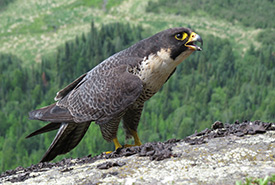
Peregrine falcon, ON (Photo by Brian Ratcliff)
There was a time when I never thought I’d see a peregrine falcon. I grew up in the 1970s, a time when the peregrine falcon was a poster species for wildlife loss. Hinterland Who’s Who told me it was already gone from eastern Canada, where I lived. When I checked out Farley Mowat’s book Sea of Slaughter from my local library in Kitchener, I read that the peregrine falcon was on the verge of extinction. As a kid, it seemed as elusive and mysterious as a tiger or rhino; its fate equally uncertain.
A grim outlook
Back then it seemed that the world’s fastest bird couldn’t escape extinction. Populations had crashed due to a one-two punch of shooting and pollution. Like many birds of prey, it had been shot by farmers and hunters for more than a century over the concern that it was feeding on game and livestock.
As a top predator, pesticides, including DDT, were building up in the birds' bodies from consuming contaminated prey. This resulted in deformed chicks or egg shells so thin they would break. No new peregrine falcons were being born.
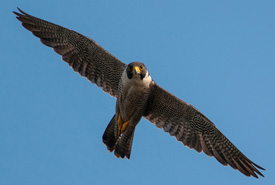
Peregrin falcon, BC (Photo by Stuart Clarke)
Peregrine falcon populations declined throughout Canada and the world. By 1970, there was just one nest recorded in southern Canada, east of British Columbia. Only one-third of historic nesting sites were still being used in the Rocky Mountains. Peregrine falcon numbers had declined in most of the over 200 nations where it was found, and vast parts of its former range in the northern hemisphere were empty.
The peregrine falcon became a symbol for what was wrong with the world in the 1970s, as author Rachel Carson’s post-war caution of a "silent spring" due to chemicals like DDT became clearly real. It was listed as endangered in the U.S. in 1970 under the Endangered Species Conservation Act (later replaced by the Endangered Species Act) and was among the first species to be assessed as endangered when the Committee on the Status of Endangered Wildlife in Canada (COSEWIC) first met in 1978.
A beacon of hope and the road to recovery
Fortunately, by the time the peregrine falcon was officially assessed as endangered in Canada, there were already many people working to save it. Although falcons and other birds of prey were excluded from the Migratory Birds Convention Act in 1917, an agreement between Canada and U.S. to conserve most migratory birds, by the 1960s almost all provinces and states had laws to protect them from being shot. These laws reflected changing attitudes toward wildlife, particularly predators. Also, many of the chemicals causing nesting failure had been banned and were slowly working their way out of the food chain. A foundation for the peregrine falcon’s recovery had started.
Government and conservation organizations started programs to breed and release peregrine falcons into places where it had been lost. They discovered this bird could also live in cities, and would substitute tall buildings for cliffs and feed on the pigeons that share our urban landscapes.
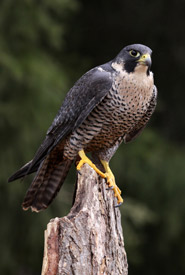
Peregrine falcon (Photo by Chris Hill)
For many reasons, things got better for the peregrine falcon. The subspecies1 that inhabits southern Canada moved along the road to recovery; from an original COSEWIC assessment of endangered in 1978, to threatened in 1999, to special concern in 2007.
Then in 2017, after 39 years on Canada’s list of endangered wildlife, they were assessed as not at risk. Although the subspecies of peregrine falcon that lives along BC’s coast is still assessed as special concern2, the population that occurs across the rest of Canada will probably not go extinct. The peregrine falcon’s story of recovery should inspire conservation for other Canadian species that have been pushed toward the edge of extinction.
Lest we forget
Extinction and recovery can happen at a slow pace. Gradual extinctions can go unnoticed, as we slip into a collective ecological amnesia about the world that was. Laborious recoveries can go uncelebrated as we forgot about the past efforts that have created the world that is.
Today, my children can see peregrine falcons just a few blocks from the Kitchener Public Library, where I first checked out Farley Mowat’s book that forecasted its demise from the skies. That gives me hope.
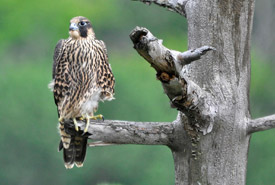
Peregrine falcon (Photo by Jean-François Plouffe)
It was a long road to recovery that had little to do with a falcon. Recovery required changing people’s values, new agreements by governments and a rethinking of agricultural and industrial practices. It also meant re-establishing healthy populations of peregrine falcons and protecting their habitat in places such as Johnson’s Mills along the Bay of Fundy and Quebec’s Piedmont and Prévost escarpments.
The peregrine falcon provides us with a model for recovery: reduce threats, increase numbers and, perhaps most importantly, get people to care.
Pollution is still a threat to some endangered wildlife, such as rusty-patched bumble bee. Some species, like prairie rattlesnake, are still persecuted. But the main threat to all Canadian wildlife is, without question, the loss of habitat.
Saving habitat for species and people
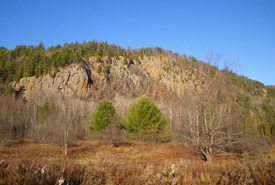
Alfred-Kelly Nature Reserve, QC (Photo by NCC)
We can protect habitat, and we certainly have a golden opportunity through the Natural Areas Conservation Program. But we know that we need to do more. It’s critical that wildlife habitat conservation becomes a Canadian value. That it becomes something that most people care about. Today, few people would support dousing forests with DDT, or the indiscriminate shooting of hawks, eagles and falcons. We need to build on those values. Wildlife conservation would have failed if we didn’t stop using DDT. Wildlife conservation would have failed without ending indiscriminate shooting. Wildlife conservation will fail if we don’t protect habitat.
For many Canadians, the value of protecting wildlife habitat is already deeply rooted in our identity — from national parks to our long history of wildlife stewardship by landowners. For others, the value of habitat protection is shaped by the benefits that nature provides to people, such as drinking water and flood control. It doesn’t matter why people care about habitat protection; we just need to make sure more people understand why habitat conservation matters now, and why it will matter even more in the future.
We need to pay attention to our natural world. The decline of the peregrine falcon was an early warning of an unhealthy planet. In the end, it may not have been us that saved a falcon, but a falcon that saved us.
1 Peregrine Falcon anatum subspecies. This subspecies and the northern subspecies (tundrius) were combined into one unit for assessment in 2007.
2 Peregrine Falcon pealei subspecies


